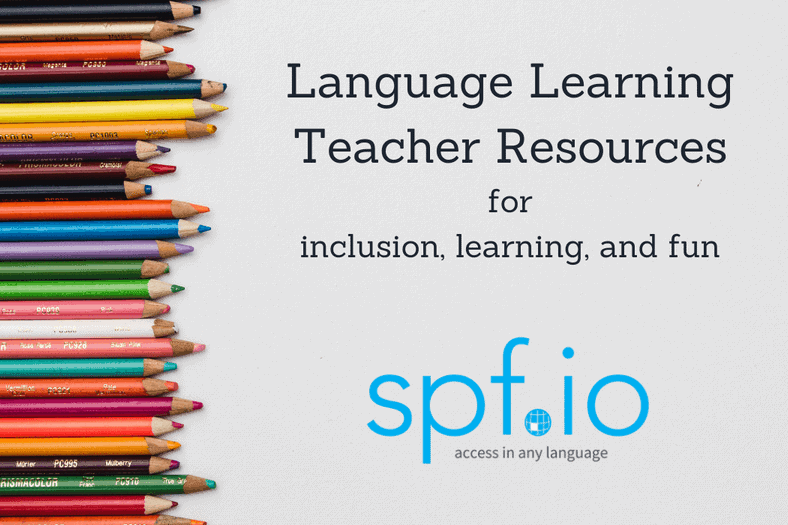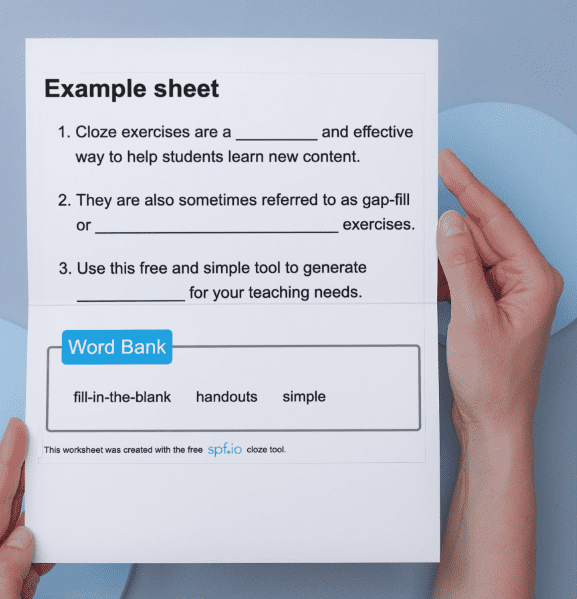Students get frustrated with language learning listening exercises because they are just plain hard. What if they could learn from fun TikTok clips and YouTube videos, instead? What if you could turn the videos your students already like and care about into a language learning lesson? That’s what spf.io helps you do. It’s a multilingual web app that should be in every teacher’s toolkit.
cloze definition
of, relating to, or being a test of reading comprehension that involves having the person being tested supply words which have been systematically deleted from a text.
– Merriam-Webster
Spf.io lets you create cloze (fill-in-the-blank) exercises from any video/audio file. Repetition is key to building vocabulary, and students can watch clips multiple times. Each time they see the video, they recognize more words. Even if they start out completely lost, you can help them with context clues for different genres:
- Who are the main characters? (story, play)
- Where is the story taking place? (story, documentary)
- What objects/words do you recognize in the scene? (any genre)
Cloze exercises can be done individually, worked on in groups, or completed using a combination of individual/team work. For example, after the first video viewing (or even before you show the video), students can work in groups to guess what the words in the blanks are. Each team writes their answers on the board and compares them (you can even make it into a game where you award points to teams based on correct answers). Then, play the recording a few more times while teams/individuals solve the cloze puzzle with more accuracy.
How do I prepare for this activity?
First, you need accurate video captions/transcripts. You can use a YouTube video, but we all know that YouTube captions aren’t always accurate. It takes time to find a clip with accurate captions to show in class.
Instead, use spf.io! Spf.io automatically captions and transcribes any downloaded video you like (file formats: mp4, m4a, mp3, etc.). It also makes editing transcripts a breeze so you can improve accuracy. This puts you in charge – no more scrubbing through videos to find a perfectly captioned clip. Then, use our free cloze tool (subscribe below for early access) to create language exercises for your class.
Can I really get captions for any video?
Yes! Spf.io supports captioning in other languages like German, Spanish, and French. You can even have students choose the video – ask them to share something important about their culture, hometown, hobbies, or other things they care about. Students get excited when they can show and tell.
With an engaged classroom, everyone feels included. The magic of using spf.io this way is that it lets every student know they matter, and their experiences are welcome in your classroom.
FAQ
What are cloze exercises?
Cloze exercises are useful tools to expand students’ vocabulary, teach language structure, and provide opportunities to learn language using context clues. These fill-in-the-blank exercises are popular in language learning settings, but they can also be used to build vocabulary and understanding/memorization of key concepts for other subjects like science, social studies, and more.
To make a cloze exercise, teachers choose a reading passage (captions from a video, a story, etc.) and remove words so that students can fill in the missing terms to complete the exercises. Specific words can be removed to build vocabulary from a word bank, where students make the correct selection from a provided set of words. With a more general application for reading comprehension, a teacher might choose to remove words at regular intervals (ex. Every 5-8 words).
How does spf.io make it easy to create practical language learning exercises?
- Basic free cloze tool – easily create your own handouts and exercises
- Make exercises with your content of choice (any video you can download in a .mp4 .m4a, .mp3, .wav format)
- spf.io is multilingual – get captions, subtitles, and transcripts in many languages
What makes cloze exercises so popular and successful?
Cloze exercises are preferred by teachers and testers because they help language learners in a variety of ways:
- They build on prior knowledge
- They can teach language structure
- They teach reading comprehension
- They build metalinguistic skills
- They are inclusive and can be adapted for different learning styles and needs
Quick tips to make cloze exercises fun:
- Choose videos with familiar settings, topics, and characters to build student confidence with context clues (for example, Harry Potter or a night market). Language learners feel more confident when they are provided with natural settings they recognize.
- Make it interactive: have students work in groups to teach each other and solve puzzles together
- Repetition is your friend: don’t skip anticipatory/pre-viewing exercises! Students learn best when building on prior knowledge (NRC 2000), so prompting them to come up with words they already know, concepts they recognize, and context clues they hear or see helps them feel and be more successful.
Examples of lesson plan exercises:
(Click here to download these ideas in a PDF)
1. Fill-in-the the blank
Sharks lose their _____ all the time – throughout their entire _____.
Answer:
Sharks lose their teeth all the time – throughout their entire lives.Have students fill in the blanks from a collection of words (a “word bank”).
For more advanced students, you can omit the word bank and have them listen for the correct term.
2. Choose the correct word/spelling of the word
Sharks (loose/loop) their teeth all the time – throughout their entire (lives/likes).
Have students choose between the two words in brackets. Words can be different parts of speech, incorrect vocabulary, or misspelled words (ex. “lives” vs “lifes”).
3. Write captions for a video (creative writing option.)
Have students transcribe a video or partially transcribe one. Before the exercise, ask them to discuss context clues. Have students identify the main characters, emotions, and events of the video.
For a creative writing option, give students the first half of the transcript and have them write the ending of the story.
References:
National Research Council. (2000). How People Learn: Brain, Mind, Experience, and School: Expanded Edition. Washington, DC: The National Academies Press.
Free tools for teachers!
📚 Get access to free teacher resources:
The FREE cloze (fill-in-the-blank) creation tool above, lesson plan ideas, and more!
🚀 Sign up below to download and access these free resources! 🚀


